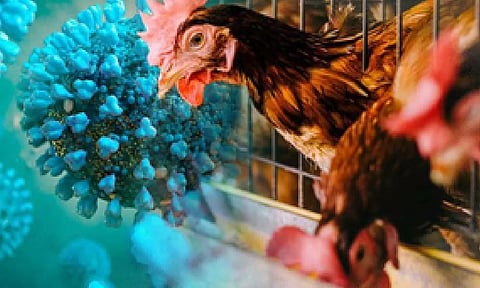

NEW DELHI: Detection of avian or bird flu in two humans in the US and one in Australia shows that the virus has adapted for circulation in mammals, raising fresh concerns over the risk of spillover to humans, said experts on Thursday.
The bird flu virus H5N1 has in recent years seen a significant increase in spillover to mammals. Besides killing a record number of birds in 2023, the virus also spread to otters, sea lions, minks, foxes, dolphins, and seals, among others.
“The reason for concern is that this virus appears to be spilling over to mammals lately, and in rare instances, to man. This shows that the virus has recently adapted for circulation in mammals,” Dr Rajeev Jayadevan, co-chairman of the Indian Medical Association’s National Covid-19 Task Force, told IANS.
“There is no doubt that human infection with highly pathogenic avian influenza (HPAI) A, H5N1 type virus that primarily causes bird flu, has a lot of potential for severe respiratory infection as well as high mortality. But the biggest solace is the fact that human-to-human transmission is extremely rare and almost not heard of,” added epidemiologist Dr. Ishwar Gilada.
Human cases of H5N1
Early this year, H5N1 infected dairy cows in the US and the virus fragments were also detected in pasteurised milk sold in stores. In April, a man from Texas working on the dairy farms reportedly became the first human in the US to contract the virus from sick cattle.
On Wednesday, the US Centers for Disease Control and Prevention (CDC) reported the second human case of highly pathogenic avian influenza (HPAI) A in a dairy farm worker in Michigan.
The CDC noted that the man is a worker on a dairy farm where the H5N1 virus has been identified in cows. In a separate case, health authorities in Australia’s Victoria reported the first case of H5N1 in a child, who picked up the infection from India before traveling to Australia.
“The big question is whether the virus goes a further step and mutates enough to spread from man to man, in which case it could become a very serious situation,” Dr. Rajeev said.
“It is because, unlike other common strains of influenza such as H1N1 that circulate in man, our immune system has no memory of the Highly Pathogenic Avian Influenza (HPAI) H5N1 strain as it was never exposed to it. That also explains the high mortality rate of close to 50 per cent,” he added.
Moreover, currently used influenza vaccines do not cover this strain, the doctor said.
According to data from the World Health Organization, from 2003 to 2023, a total of 873 human cases of infection with influenza A (H5N1) and 458 deaths have been reported globally from 21 countries.
However, to date, no sustained human-to-human transmission has been detected.
The future of H5N1 Citing the advent of Ebola, Zika, Nipah, HIV, SARS, Covid-19, etc., seen particularly in the last four decades, Dr. Ishwar told IANS that there has been a “trend of viral infections that are mostly zoonotic diseases — animal to human transmission — and then human to human transmission”.
“The virus could mutate for easier transmission. Hence, the need for monitoring and controlling outbreaks in the poultry population in case of H5N1 is all the more important,” he said.
Dr. Rajeev noted that 27 years ago in 1997, a small cluster of H5N1 was identified in Hong Kong, where the bird flu virus apparently spread among people.
“But it did not go on to become an epidemic. Therefore, the world of science is watching closely whether clusters of H5N1 cases occur among humans. It is theoretically possible for the H5N1 virus to make these adaptations either by gradually adding further mutations or by mixing its genetic material with a human-adapted influenza virus simultaneously infecting the same animal or person,” he added.
While stressing the need for pandemic preparedness at global, national, state, and local levels, Dr. Ishwar also called out against creating unnecessary panic.